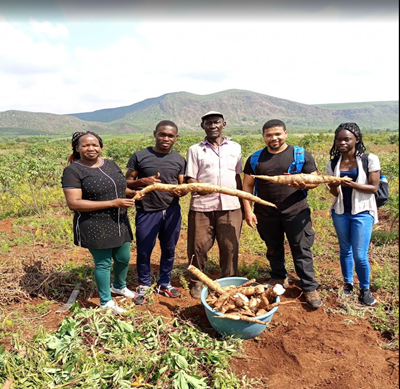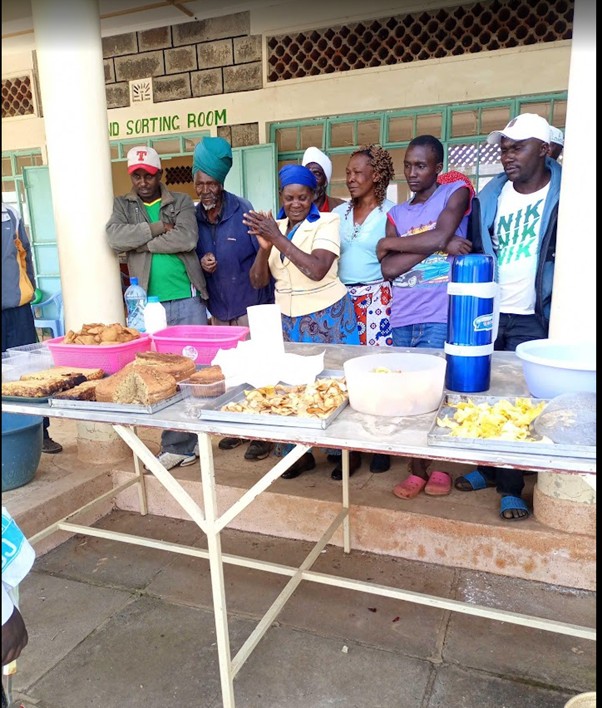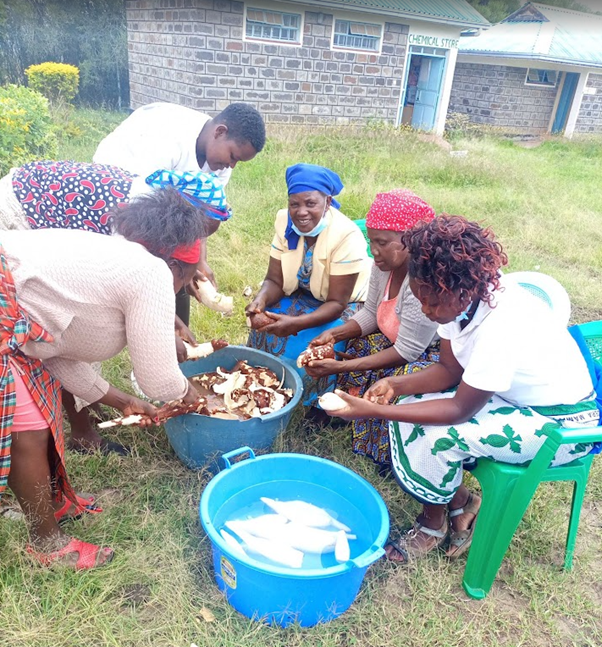
 International students (US) and researchers visiting Mr. Joseph Muigai, a project beneficiary and cassava farmers in Solai, Nakuru county./KNA
International students (US) and researchers visiting Mr. Joseph Muigai, a project beneficiary and cassava farmers in Solai, Nakuru county./KNA
In the sun-scorched plains of Solai in Nakuru County, farmer Joseph Muigai, stands proudly beside his exhibition stand of his cassava crop.
For years, he struggled to grow maize, only to see it fail under the relentless heat and erratic rains.
Today, his cassava plants are lush, hardy, and full of promise — a symbol of hope in a region long plagued by food insecurity.
Joseph’s story is echoed across Kenya’s Arid and Semi-Arid Lands (ASALs), where cassava is emerging as a quiet hero.
In a world where 733 million people faced hunger in 2023, one in every eleven globally, Africa bears a disproportionate burden, with one in five people affected (WHO, 2024; IPC, 2023).
Kenya is no exception: more than 5.4 million people, or roughly 10 percent of the population, live in chronic food insecurity, worsened by climate change, failed maize harvests, and diets that are high in protein but low in energy, especially in pastoralist communities.
At the 2025 Evidence for Development Conference held 6th to 8th May 2025, Dr. Milcah Wambua, a researcher from Egerton University, made a compelling case for cassava’s role in reshaping Kenya’s food systems.
Her presentation,“Enhancing Cassava Research for Climate-Resilient Food Systems in Kenya: A Pathway to Agenda 2063”, outlined the transformative potential of this humble root.
“Cassava is the climate-smart champion for Kenya's ASALs, resilient in drought, rich in nutrients, and a reliable pillar against food insecurity. If we’re serious about ending hunger and achieving climate-resilient food systems,” we must rethink what we grow, how we grow it, and who benefits from it. Cassava isn't just a crop; it’s a climate-smart solution,” said Dr. Wambua.
 Farmers in Solai participated in the cassava value addition training./KNA
Farmers in Solai participated in the cassava value addition training./KNA
Trials were conducted on actual farms in Solai, Lower Subukia, and Lare, showcasing the crop’s adaptability to harsh, arid conditions.
Among the top-performing varieties were Selele, Okonyo Welo, Karembo, and MM99/4884, all noted for their high yields, drought tolerance, and resistance to cassava mosaic disease.
Cassava’s nutritional profile, high in carbohydrates and energy, makes it especially valuable in regions where diets often lack balance. But its low protein content and limited consumer appeal present hurdles.
Researchers have tackled this by creating fortified cassava products that improve both taste and nutrition.
One innovation involved enriching high-quality cassava flour with camel milk, producing nutrient-dense biscuits that are both tasty and healthy.
 Farmers in Solai participated in the cassava value addition training./KNA
Farmers in Solai participated in the cassava value addition training./KNA
“These biscuits aren’t just nutritious, they’re also delicious and familiar,” said Nancy, a mother from Njoro. “Even my children ask for more.”
The cassava initiative is also changing lives economically, particularly for women and youth. In Solai and Subukia, women are leading processing ventures, milling, baking, and selling cassava products in local markets. Youth groups have also received training in agribusiness and value addition.
“Cassava has changed how we see farming,” said Samuel, a 25-year-old agripreneur in Rongai. “It’s not just about survival anymore, it’s a business opportunity.”
These efforts support Kenya’s Vision 2030, the National Climate Change Response Strategy, and the African Union’s Agenda 2063. With evidence now available on the performance of cassava in ASALs, experts are calling for urgent investment in its value chain and community adoption.
“We now have empirical evidence, not just hope, that cassava can thrive in marginal soils and under low rainfall. The next step is for the government, donors, and the private sector to support scale-up,” said Wambua.
To realise cassava’s full potential, researchers recommend five key actions. First, promote cassava varieties that match local agro-ecological zones. Second, diversify cassava products to include items like bread, biscuits, cakes, and ugali.
Third, fortify cassava with locally available, nutrient-rich ingredients such as camel milk and legumes. Fourth, strengthen extension services to train farmers and processors.
Fifth, create niche markets to increase incomes for smallholder farmers and other value chain actors.
Cassava’s resilience, nutritional potential, and economic promise make it an ideal candidate for climate-smart agriculture in Kenya. Once dismissed as the "poor man’s crop," it is now being recognized for its role in transforming food systems.
In Eastern Kenya, which includes large parts of the Arid and Semi-Arid Lands (ASALs), a research project funded by the Mawazo Institute is working to improve cassava production.
Led by a principal investigator and a team of six women researchers, the project is conducting a baseline study to identify the challenges farmers face in growing, processing, and adding value to cassava.
Although the region is suitable for cassava, it produces less than 10 percent of the national total. The project aims to promote cassava as a food and cash crop. The findings will be shared in a policy workshop and used to train farmers, based on models used in Nakuru County.
With targeted investment and community-driven innovation, cassava could help Kenya meet its development goals and secure a more sustainable, resilient, and food-secure future.
As Joseph in Solai puts it: “Cassava gave me back my dignity. I don’t beg for food anymore. I will always grow it.”











